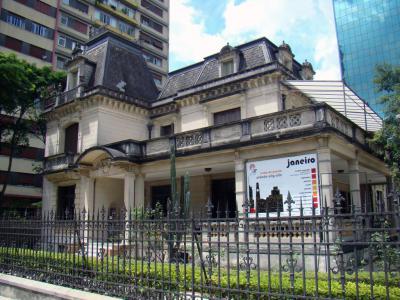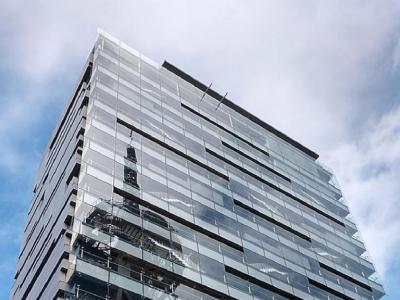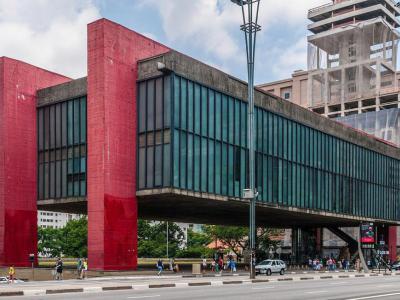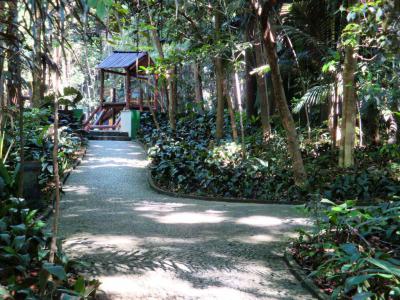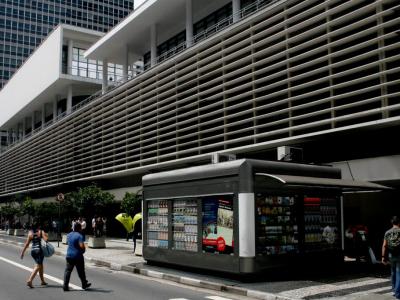Paulista Avenue Walking Tour (Self Guided), Sao Paulo
One of the main arteries of Sao Paulo, Paulista Avenue is a famous location and a symbol of the city's economic and political power. On both sides the avenue is lined with impressive high-rising architecture, extensive shopping areas, and cultural institutions.
The history of skyscrapers in Sao Paulo started in the late 1930s with the first multi-story edifice constructed at the corner of Paulista and Frei Caneca. The most important of those buildings still in place is Casa das Rosas (The House of Roses), located at the very outset of the avenue. Fitted with oil/hydraulic heat radiators – a luxury only the millionaire could afford back in the day, the house was turned into a cultural center in the late 1980s.
Paulista is also home to the most comprehensive fine-art museum in South America, called the Sao Paulo Museum of Art (MASP - Museu de Arte de Sao Paulo), which is one of the city's most controversial architectural landmarks. The exhibition space here is made of a single block of concrete with glass windows, suspended and supported by two vertical concrete columns. But most importantly, MASP is known for the excellent collection of European and national paintings, sketches, and sculptures by the likes of Renoir, Picasso and Brazilian Modernist artists.
Situated nearby is a small native forest park, Parque Siqueira Campos, commonly known as Trianon. Found in the vicinity is a multitude of large-scale shopping malls, such as Conjunto Nacional and more, noted for their boutique stores, coffee shops, restaurants, luncheonettes, and movie theaters.
To take a closer look at all these and other attractions of Sao Paulo, take this self-guided tour of Paulista Avenue.
The history of skyscrapers in Sao Paulo started in the late 1930s with the first multi-story edifice constructed at the corner of Paulista and Frei Caneca. The most important of those buildings still in place is Casa das Rosas (The House of Roses), located at the very outset of the avenue. Fitted with oil/hydraulic heat radiators – a luxury only the millionaire could afford back in the day, the house was turned into a cultural center in the late 1980s.
Paulista is also home to the most comprehensive fine-art museum in South America, called the Sao Paulo Museum of Art (MASP - Museu de Arte de Sao Paulo), which is one of the city's most controversial architectural landmarks. The exhibition space here is made of a single block of concrete with glass windows, suspended and supported by two vertical concrete columns. But most importantly, MASP is known for the excellent collection of European and national paintings, sketches, and sculptures by the likes of Renoir, Picasso and Brazilian Modernist artists.
Situated nearby is a small native forest park, Parque Siqueira Campos, commonly known as Trianon. Found in the vicinity is a multitude of large-scale shopping malls, such as Conjunto Nacional and more, noted for their boutique stores, coffee shops, restaurants, luncheonettes, and movie theaters.
To take a closer look at all these and other attractions of Sao Paulo, take this self-guided tour of Paulista Avenue.
How it works: Download the app "GPSmyCity: Walks in 1K+ Cities" from Apple App Store or Google Play Store to your mobile phone or tablet. The app turns your mobile device into a personal tour guide and its built-in GPS navigation functions guide you from one tour stop to next. The app works offline, so no data plan is needed when traveling abroad.
Paulista Avenue Walking Tour Map
Guide Name: Paulista Avenue Walking Tour
Guide Location: Brazil » Sao Paulo (See other walking tours in Sao Paulo)
Guide Type: Self-guided Walking Tour (Sightseeing)
# of Attractions: 7
Tour Duration: 1 Hour(s)
Travel Distance: 2.1 Km or 1.3 Miles
Author: vickyc
Sight(s) Featured in This Guide:
Guide Location: Brazil » Sao Paulo (See other walking tours in Sao Paulo)
Guide Type: Self-guided Walking Tour (Sightseeing)
# of Attractions: 7
Tour Duration: 1 Hour(s)
Travel Distance: 2.1 Km or 1.3 Miles
Author: vickyc
Sight(s) Featured in This Guide:
- Casa das Rosas (House of Roses)
- SESC Paulista
- Shopping Cidade São Paulo (Shopping City Mall)
- Sao Paulo Museum of Art
- Trianon Park
- Residência Joaquim Franco de Melo (Joaquim Franco de Mello House)
- Conjunto Nacional
1) Casa das Rosas (House of Roses)
House of Roses is an art and poetry center that features a French style design. Built between 1928 and 1935 by the office of architect Francisco de Paula Ramos de Azevedo, the four-story building is one of the last mansions built in the city of Sao Paulo. House of Roses currently serves as a poetry and arts center.
The interior of the mansion features a mix of styles from Art Deco, Renaissance, Neoclassical, and English. Belgian glass and crystals decorate the dwelling and the entrance-way features a stone and marble design. Two of the most stunning elements of the 30-room house are the garden and stained-glass window that greets all who pass through the entrance hallway. The garden is known as one of the most beautiful in Sao Paulo.
Photography, writing, poetry, other artistic events occur regularly. In addition, the country’s first library is located in the building. The library features a collection of books from Ramos de Azevedo and rare first collection books. You must receive permission in advance to photograph the interior. Photography of the exterior is allowed with certain restrictions.
In addition to cultural events, courses and periodic exhibitions, it has one of the city's largest and most beautiful rose gardens. In the back of the mansion is a coffee shop-restaurant, offering indoors as well as pleasant outdoors sitting – good place for a quiet lunch! House of Roses is a treat you should not miss.
The interior of the mansion features a mix of styles from Art Deco, Renaissance, Neoclassical, and English. Belgian glass and crystals decorate the dwelling and the entrance-way features a stone and marble design. Two of the most stunning elements of the 30-room house are the garden and stained-glass window that greets all who pass through the entrance hallway. The garden is known as one of the most beautiful in Sao Paulo.
Photography, writing, poetry, other artistic events occur regularly. In addition, the country’s first library is located in the building. The library features a collection of books from Ramos de Azevedo and rare first collection books. You must receive permission in advance to photograph the interior. Photography of the exterior is allowed with certain restrictions.
In addition to cultural events, courses and periodic exhibitions, it has one of the city's largest and most beautiful rose gardens. In the back of the mansion is a coffee shop-restaurant, offering indoors as well as pleasant outdoors sitting – good place for a quiet lunch! House of Roses is a treat you should not miss.
2) SESC Paulista
SESC Paulista is a cultural center in a very modern building. The exterior employs non-reflective glass. It also boasts one of the best views of the famous Paulista Avenue. Visitors that reach the 17th floor are treated to a panoramic view of Paulista and São Paulo. Go at sunset for the most dramatic pictures. The top floor also features a delightful Terrace Café.
The other floors host a variety of exhibitions and spaces. SESC is a private Brazilian institution focusing on health, technology, and art. Visitors will find various shops, a library, and a children's room.
On the ground floor, you'll find modern exhibitions with audio-visual presentations and technologically advanced installations. On the third floor, you'll find a fabulous space for children, with toys, a lunchroom, and restrooms. The sixth floor hosts a gallery and exhibitions.
On the 10th, 11th, and 12th floors, visitors will find gyms, a gymnastics studio, a pilates studio, and space for other sports. The 15th floor hosts an extensive library with comfortable reading areas. You'll find books, magazines, newspapers, and comics. The library also hosts workshops and writer meetings.
On the 16th floor, Comedoria offers lunch, dinner, and snacks.
The other floors host a variety of exhibitions and spaces. SESC is a private Brazilian institution focusing on health, technology, and art. Visitors will find various shops, a library, and a children's room.
On the ground floor, you'll find modern exhibitions with audio-visual presentations and technologically advanced installations. On the third floor, you'll find a fabulous space for children, with toys, a lunchroom, and restrooms. The sixth floor hosts a gallery and exhibitions.
On the 10th, 11th, and 12th floors, visitors will find gyms, a gymnastics studio, a pilates studio, and space for other sports. The 15th floor hosts an extensive library with comfortable reading areas. You'll find books, magazines, newspapers, and comics. The library also hosts workshops and writer meetings.
On the 16th floor, Comedoria offers lunch, dinner, and snacks.
3) Shopping Cidade São Paulo (Shopping City Mall)
Shopping Cidade São Paulo was built on the site of the Matarazzo family mansion. Opened in 2015, this mall is modern, bright, and welcoming. Visitors will love the open-air garden at the Pamplona Street entrance.
There's a cinema, food court with American and Brazilian treats, coffee shops, and gelato and chocolate stores. There are also a few full-service sit-down restaurants.
This beautiful shopping mall has a little of everything. With 160 stores and five levels, you're sure to find what you are looking for. Visitors will find American brands, international brands, and local brands. Shop for clothing, shoes, books, and accessories.
There's a cinema, food court with American and Brazilian treats, coffee shops, and gelato and chocolate stores. There are also a few full-service sit-down restaurants.
This beautiful shopping mall has a little of everything. With 160 stores and five levels, you're sure to find what you are looking for. Visitors will find American brands, international brands, and local brands. Shop for clothing, shoes, books, and accessories.
4) Sao Paulo Museum of Art (must see)
Established in 1947, the Museum of Art features fine art from Brazilian, English, French, African, Italian, Asian, and Latin American disciplines. The exhibition hall contains a collection of 8,000 items that features greats such as Renoir, Van Gogh, Matisse, Picasso, Warhol, Rubens, Rembrandt, Raphael, Boticelli, and Monet. It is one of the most extensive and largest collections of Western art in Latin America and the Southern Hemisphere. The current museum was inaugurated by Queen Elizabeth II during her 1968 visit to Brazil.
Located on the famous Paulista Avenue, the museum is locally known as the Museu de Arte. Designer Lina Bo Bardi is responsible for the two grand red lateral beams that grace the building. The beams support the building and enable the view of other buildings to remain unobstructed.
The building is much more than just a museum. A library, film gallery, photo gallery, two auditoriums, store, restaurant, and workshop rooms are available for public use. Concerts and other events are frequently held in the marketplace. Visitors should make sure to attend the antique market that happens every Sunday in the bazaar. Art courses are held for all who wish to attend.
Why You Should Visit:
The most famous museum in São Paulo, and for good reason: two floors of beautiful masterpieces from around the world! Downstairs is an excellent museum shop and very good cafe; however, Paulista Avenue is full of good eating options as well.
Tip:
Visit it on Tuesdays, when the admission is free, and focus on the main exhibition on the top floor, where most true gems are. If you want to know what you see, you have to walk around the back of the painting!
Located on the famous Paulista Avenue, the museum is locally known as the Museu de Arte. Designer Lina Bo Bardi is responsible for the two grand red lateral beams that grace the building. The beams support the building and enable the view of other buildings to remain unobstructed.
The building is much more than just a museum. A library, film gallery, photo gallery, two auditoriums, store, restaurant, and workshop rooms are available for public use. Concerts and other events are frequently held in the marketplace. Visitors should make sure to attend the antique market that happens every Sunday in the bazaar. Art courses are held for all who wish to attend.
Why You Should Visit:
The most famous museum in São Paulo, and for good reason: two floors of beautiful masterpieces from around the world! Downstairs is an excellent museum shop and very good cafe; however, Paulista Avenue is full of good eating options as well.
Tip:
Visit it on Tuesdays, when the admission is free, and focus on the main exhibition on the top floor, where most true gems are. If you want to know what you see, you have to walk around the back of the painting!
5) Trianon Park
Trianon Park, also known as the Lieutenant Siqueira Campos Park, is a 48,000 square meter recreational area that offers visitors a glimpse of the Atlantic tropical forest. The park was established in 1892. French landscape designer Paul Villon created the layout.
The picturesque and spacious area was originally created for high society. This could explain the lushness that one encounters as they walk through the trails and walkways. The park perfectly blends nature and art. Some parts of the forest have been converted into walkways or trails while other areas have been converted into playgrounds for children. Statues of nymphs, fawns, and other objects are far and wide. The park is the perfect way for locals and visitors to take a break from the hustle and bustle of everyday life.
Shade and benches are plentiful. In addition, a workout area is available for those who wish to stay fit. Native plants, birds, and insects are plentiful. The landscape is dotted by the world-famous Brazilwood trees which are highly valued for musical instrument construction. Tourist guides are plentiful, helpful, and speak Portuguese, English, and Spanish. Maps are available at the tourist center for those who are unfamiliar with the layout of the park.
The picturesque and spacious area was originally created for high society. This could explain the lushness that one encounters as they walk through the trails and walkways. The park perfectly blends nature and art. Some parts of the forest have been converted into walkways or trails while other areas have been converted into playgrounds for children. Statues of nymphs, fawns, and other objects are far and wide. The park is the perfect way for locals and visitors to take a break from the hustle and bustle of everyday life.
Shade and benches are plentiful. In addition, a workout area is available for those who wish to stay fit. Native plants, birds, and insects are plentiful. The landscape is dotted by the world-famous Brazilwood trees which are highly valued for musical instrument construction. Tourist guides are plentiful, helpful, and speak Portuguese, English, and Spanish. Maps are available at the tourist center for those who are unfamiliar with the layout of the park.
6) Residência Joaquim Franco de Melo (Joaquim Franco de Mello House)
This elegant mansion is the only remaining home from the residential phase of Paulista Avenue. Between 1891 and 1937, wealthy São Paulo coffee barons, industrialists, and merchants built their exclusive mansions on the newest and trendiest avenue in the city. Colonel Joaquim Franco de Mello was a wealthy farmer, and the family occupied the mansion for most of the early 20th century.
The Residência Joaquim Franco de Melo was built in 1905. This eclectic style home is influenced by Louis XV-era European architecture. Rococo ornamentation, Rennaissance-style framed windows, a French-style turret, and Moorish-style towers all add to the mixture of styles and make a unique and captivating mansion.
Today, all of the other mansions along Paulista Avenue have been torn down to build skyscrapers and financial centers. The government listed the mansion as a historical property decades ago. The mansion then became a source of contention between the government and the de Mello heirs. The property fell into disrepair, and the beautiful exterior was covered in graffiti. In 2019, the family and government finally agreed, and the family transferred the property to governmental control.
The Residência Joaquim Franco de Melo was built in 1905. This eclectic style home is influenced by Louis XV-era European architecture. Rococo ornamentation, Rennaissance-style framed windows, a French-style turret, and Moorish-style towers all add to the mixture of styles and make a unique and captivating mansion.
Today, all of the other mansions along Paulista Avenue have been torn down to build skyscrapers and financial centers. The government listed the mansion as a historical property decades ago. The mansion then became a source of contention between the government and the de Mello heirs. The property fell into disrepair, and the beautiful exterior was covered in graffiti. In 2019, the family and government finally agreed, and the family transferred the property to governmental control.
7) Conjunto Nacional
The Conjunto Nacional project sought to blend different uses in the same structure. This massive project was the first of its kind. Architect David Libeskind spearheaded this modern enterprise, and construction was completed in 1956.
The horizontal part of Conjunto Nacional takes up an entire city block. This component hosts a shopping mall. Here, you will find a myriad of shops, clothing stores, movie theaters, bank branches, and restaurants. Try a pão de queijo, the popular Brazillian cheese bread ball, at one of the cafés.
The famous bookstore Livraria Cultura is located here. This is the largest bookstore in Latin America and is worth a look. The vertical portion of the Conjunto Nacional is home to apartments and offices.
The clock of the National Assembly is located on the top of Edificio Horsa and can be seen from 5 miles away.
The horizontal part of Conjunto Nacional takes up an entire city block. This component hosts a shopping mall. Here, you will find a myriad of shops, clothing stores, movie theaters, bank branches, and restaurants. Try a pão de queijo, the popular Brazillian cheese bread ball, at one of the cafés.
The famous bookstore Livraria Cultura is located here. This is the largest bookstore in Latin America and is worth a look. The vertical portion of the Conjunto Nacional is home to apartments and offices.
The clock of the National Assembly is located on the top of Edificio Horsa and can be seen from 5 miles away.
Walking Tours in Sao Paulo, Brazil
Create Your Own Walk in Sao Paulo
Creating your own self-guided walk in Sao Paulo is easy and fun. Choose the city attractions that you want to see and a walk route map will be created just for you. You can even set your hotel as the start point of the walk.
Ibirapuera Park Walking Tour
Located in the very heart of Sao Paulo, Ibirapuera Park is the city's most famous attraction. The park was designed by architect Oscar Niemeyer together with landscapist Roberto Burle Marx. It opened to the public on the 21st August, 1954. With a total space of 2 million square meters, the park features a beautiful landscape, filled with lakes, fountains, monuments, theaters, playgrounds,... view more
Tour Duration: 2 Hour(s)
Travel Distance: 3.9 Km or 2.4 Miles
Tour Duration: 2 Hour(s)
Travel Distance: 3.9 Km or 2.4 Miles
Sao Paulo Introduction Walking Tour
When Jesuit priest José de Anchieta founded the mission in 1554, he reportedly said that the site, though modest, would “become a great village.” Sao Paulo never stops. From this small plateau mission to one of the world’s largest cities, the metropolis has always been shaped by energy, ambition, and growth.
The city was established by Jesuit missionaries Manuel da Nobrega and Jose de... view more
Tour Duration: 2 Hour(s)
Travel Distance: 3.1 Km or 1.9 Miles
The city was established by Jesuit missionaries Manuel da Nobrega and Jose de... view more
Tour Duration: 2 Hour(s)
Travel Distance: 3.1 Km or 1.9 Miles
Japantown Walking Tour
Home to the world's largest ethnic Japanese community outside Japan, the Sao Paulo district of Liberdade entices tourists with its Asian-inspired influences present everywhere: restaurants, shops, decor, markets, etc.
Up until the late 19th century, the area was known as Campo da Forca (Field of the Gallows) as the one reserved for the execution of slaves and convicts – for whom the only... view more
Tour Duration: 1 Hour(s)
Travel Distance: 0.8 Km or 0.5 Miles
Up until the late 19th century, the area was known as Campo da Forca (Field of the Gallows) as the one reserved for the execution of slaves and convicts – for whom the only... view more
Tour Duration: 1 Hour(s)
Travel Distance: 0.8 Km or 0.5 Miles
The Most Popular Cities
/ view all



